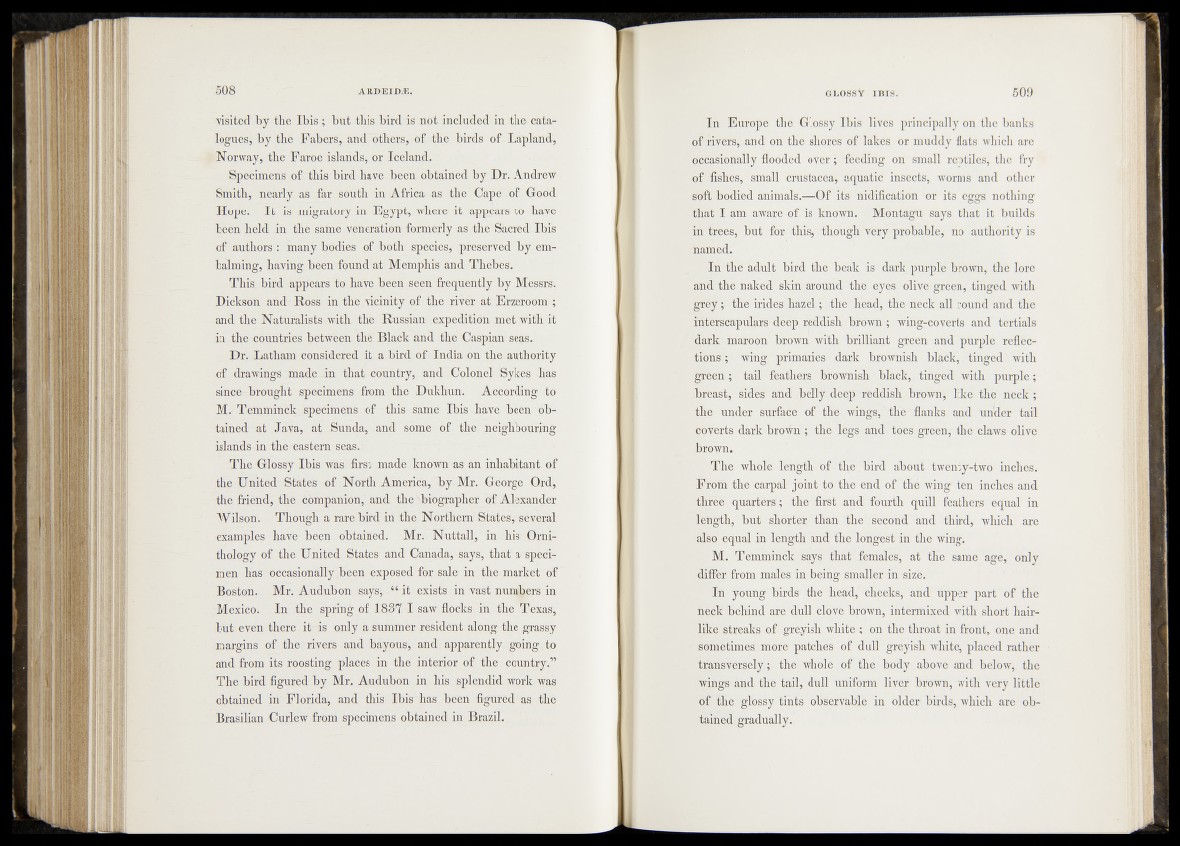
visited by the Ibis ; but this bird is not included in the* catalogues,
by the Fabers, and "others, of the birds of Lapland,
Norway, the Faroe islands, or Iceland.
Specimens of this bird have been-obtained by Dr. Andrew
Smith, nearly as far south in Africa as the Cape of Good
Hope. I t is migratory in Egypt, where -it appears tb&have
Been held in the same veneration formerly as the Sacred Ibis
of authors : many bodies of both species, preserved by embalming,
having beenfound at Memphis and Thebes.
This bird appears to have, been seen frequently by Messrs.
Dickson1 and.* Ross, in the .vicitity'of the river at Er-zeroom ;
and the Naturalists -with thfe Russian-.expedition met with.it
in the countries between the. Black and tfie'Caspian se§,s.
Dr,-Latham considered/it a bird ofwLndiaBif-Hhe authority
■of drawings 'made _in that country, and Colonel Sykes has
since -brought specimens from 'the Dukhun. According >td
M.- Temminck. specimens of this same Ibis haveib&sn "Obtained
at Java, at .Sunda, and neighbouring
islands in the-eastern seas.'; ,
The Glossy Ibis was'first-..made known as-an inhabitant ;of
the United^Stafes o f ; North America, 'by. Mr. George'>Ord,
-the Mend, the companion, and the’Sbiographer ,q£ Alexander
Wilsbii. Though a rare bird in the Northern St&teSy.'severaL
examples haveJpeen obtained. Mr. Nuttall," in-ffiis; Ornithology
of the United States and Canada,K says, that a'spe#-
men has occasionally .Been exposed for sale' in the-market of
Boston. Mr. Audubon saySf i t■ exists in vast nun^ers in
Mexico. In the spring of 1887 I saw flocks in the Texas,
but. even there it-is only a summer resident along the grassy
margins of the rivers and bayous, and apparently going, to
and from its roosting places in the interior of the country.”
The bird figured by Mr. Audubon in his. splendid work was
obtained in Florida, and this Tbis~has been figured as the
Brasilian Curlew from specimens obtained m Brazil.
In Europe the Glossy Ibis lives principally on the banks
of rivers, and on the shores of lakes or muddy flats which are
occasionally flooded over; feeding on small reptiles, the fry
of fishes, small Crustacea, aquatic insects, worms and other
soft bodied animals.—Of its nidification or its eggs nothing
that I am aware of is known. Montagu says that it builds
in 'trees,^but for this,’ though very probable, no authority is
named.
In the adult bird the beak is dark purple brown, the lore
and the naked skin around the eyes olive green, tinged with
grey; the irides hazel; , the head, the neck all round and the
interscapularsideep;‘reddish brown-; wing-coverts and tertials
dark maroon brown with brilliant -green and purple reflections
; wing primaries dark brownish black, tinged with
green; tail feathers brownish black, tinged with purple;
Jbreast, sides "and belly deep'reddish brown, like thé neck ;
the under surface of the wings,; the 'flanks and under tail
coverts dark bro^n ; the legs and toes green, the claws olive
brown.
" The whole length of the Bird about twenty-two inches.
F l i p the carpal joint to the end of thé wing ten inches and
three quarters; the first and fourth quill feathers equal in
letrgth, but shorter than the second and third, which are
also equal in length and the longest in the wing.
M. Temminck. says that females, at the same age, only
differ from malès in being smaller in size.
In young- Birds the head, cheeks, and upper part of the
neck Behind are dull clove brown, intermixed with short hairlike
streaks of -greyish white ■; on the throat in front, one and
sometimes, more patches of dull greyish white, placed rather
transversely; the whole of the’ body above and below, the
wings and the tail, dull uniform liver brown, with very little
of the glossy tints observable in older birds, which are obtained
gradually.